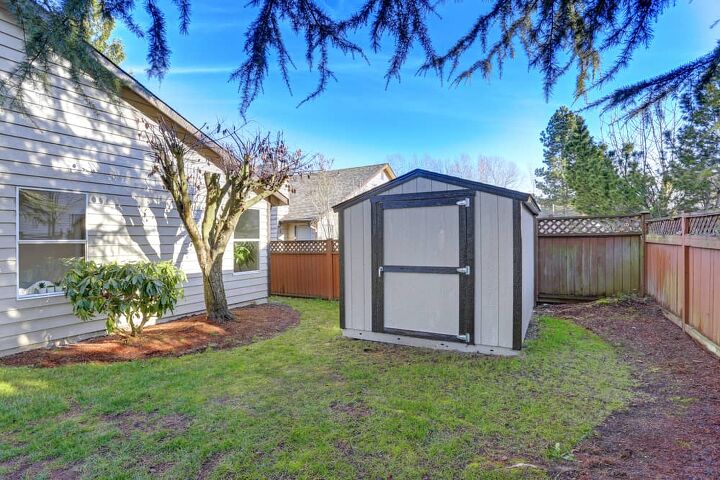How Far Does A Shed Have To Be From The Fence? (Find Out Now!)

Adding a shed to your yard is an excellent way to get more out of the space. It’ll give you a place to store your gear and can add to the overall aesthetic of your backyard area.
However, you need to do some research before putting in a new shed. There are certain legal requirements that you need to meet to ensure that you don’t receive fines or have to move the shed down the line. One example of this is the distance required between your shed and your fence.
There typically needs to be at least 5 feet of space between the far edge of your shed and the fence. Each state and municipality has different rules and regulations, but most areas recommend at least 24” of clearance around your shed on each side. Some areas require that your shed is no closer than 10-15 feet from property lines.
Do You Need to Hire Shed Installers?
Get free, zero-commitment quotes from pro contractors near you.

What Happens If I Build a Shed Along the Fence?
It can sometimes be tempting to simply disregard the legal requirements and build your shed exactly where you want it. That’s especially true if you have next-door neighbors who are okay with your building right along the property line.
However, skirting these legal requirements generally isn’t worth it. The exact penalties that you may face will vary based on your jurisdiction. However, they typically include fines, which can be quite substantial, and legal orders to remove the shed from its location.
That means that trying to get away with putting your shed right along the fence could be a costly endeavor. Your neighbors could decide after the fact that they don’t want the shed where you’ve put it. Or, they could sell their home and new neighbors could move in who don’t want to shed there.
For all of these reasons, it’s generally better to simply follow your legal requirements and install your shed where it belongs. Doing so will save you both time and money down the line.
How Much Space Do I Need Around My Shed?
It’s a good idea to leave some space around your shed for a few key reasons. First, you want to leave space to maintain the shed throughout its lifespan. You may need to perform periodic repairs, which can be quite difficult if you don’t have any space to operate in.
You may also want to add to your shed as time goes on. You’ll find this very difficult to do if you haven’t given yourself the space necessary for it. With that in mind, most experts recommend leaving at least 24 inches around the entirety of your shed. Doing so will ensure that you’re prepared for whatever you decide to do with it in the future.
Why Can’t Sheds Be Built Right Next to a Fence?
Ultimately, this is a question that can only be answered by property law and the theory behind it. Generally speaking, we want people to be able to do what they want on their properties. However, that freedom can’t come at the expense of infringing on another property owner’s freedom to do what they want with their property.
It’s this principle that has guided the creation of laws like this one. The idea is that if you build a large structure like a shed too close to your neighbor’s property, then you’re infringing on their ability to enjoy their property. Whether or not you buy this argument, the law is the law and homeowners have to work around it.
What Size Sheds Require Building Permits?
This is another question that is going to depend on where you live. For example, in California, you can build a shed that’s as large as 120 square feet without needing a building permit. The number in your state is likely very similar to this one.
That being said, size isn’t the only factor that impacts whether you need a building permit or not. You may also be required to get one if you’re building a smaller shed that has electrical or plumbing features.
Additionally, it’s important to note that a building permit isn’t the only type of permit that you may need while building a shed. Some states have what’s called a planning permit. These are generally a bit easier to get than building permits, but they still necessitate some planning on your end.
How Close to the Property Line Can I Build a Shed?
Once again, you need to consult with the code requirements where you live to get an exact answer to this question. The exact distance can vary significantly from city to city.
For example, you may be able to build as close as four feet away from your property line in some areas. Other places may ask you to stay 10-15 feet away from your property line.
It’s like that if you live in a congested area with less space, such as a major city, you can build closer to your property line. If, on the other hand, you live in a rural area with lots of space, then you probably will need to stay farther away from that line.
How High Off the Ground Should a Shed Be?
Unlike mandated minimum distances from your fence, there are no legal requirements for how high off the ground a shed needs to be. This means that you have some more freedom in this part of the shed design process.
However, that doesn’t mean that you should forget about raising your shed altogether. In fact, it’s actually something that most shed experts recommend homeowners do. There are a few reasons for this.
First, raised sheds generally have much better air circulation than do those that sit on the ground. You want better air circulation because it can be a major factor in preventing mold from growing in your shed.
Second, raising your shed off of the ground protects it from damage during the stormy season. This is especially important if you live in a part of the country where it rains a lot. By raising your shed, you can ensure that its foundation doesn’t deteriorate over time due to rainwater.
With all of this in mind, if you decide to raise your shed, you should raise it at least 4 inches off of the ground. Doing so will ensure that you enjoy the maximum benefits of air circulation and protection from the elements.
Do Sheds Need Foundations?
Legally speaking, no, you don’t need to add a foundation before building your shed. However, for sheds that are larger than 6×8 feet, it’s generally it a good idea to add one. This is true for a few reasons.
You never want to place wood directly on the ground. When you do, that wood will unavoidably absorb moisture from the ground. Over time, this can cause the wood to rot and decay prematurely. That means you’ll have to spend your time and money on replacing it much sooner than you otherwise would need to.
Also, you want to build your shed on a surface that’s as close to perfectly level as possible. This ensures that the shed itself remains stable and that its doors are able to function properly. Foundations help with this. It’s much easier to get your shed’s level right when placing it on a foundation than when placing it directly on the ground.
Do You Need to Hire Shed Installers?
Get free, zero-commitment quotes from pro contractors near you.

Related Questions
Can you put a shed on soil?
You can put a shed directly on your soil, but you probably don’t want to. Doing so would significantly increase your chances of prematurely rotting the shed’s wooden floors. You’ll extend the lifespan of your shed if you place it on a foundation like a concrete slab.
Does a shed need a vapor barrier?
A vapor barrier is a non-permeable plastic that prevents air from flowing through a structure. Generally speaking, you don’t want to install one of these inside of your shed’s walls. Doing so will lead to condensation and mold growth. However, you may want to install a vapor barrier between the concrete slab and your floor. This can prevent moisture from entering your shed through the concrete.
Do I need to vent a shed?
Yes, it’s a good idea to vent your shed. This is typically done by installing wall vents and/or ridge vents. Each of these can protect the shed from mildew and rot.
Related Guides

Kellan is a content writer who specializes in everything DIY. When he's not behind the keyboard, he enjoys spending time with his pets, playing music, and geeking out about basketball. He hopes to make your home improvement projects a little bit easier to accomplish.
More by Kellan Jansen











![10 Best Scroll Saws for 2022 [Ultimate Reviews & Buyer's Guide]](https://cdn-fastly.upgradedhome.com/media/2023/07/31/9070684/10-best-scroll-saws-for-2022-ultimate-reviews-buyer-s-guide.jpg?size=350x220)















